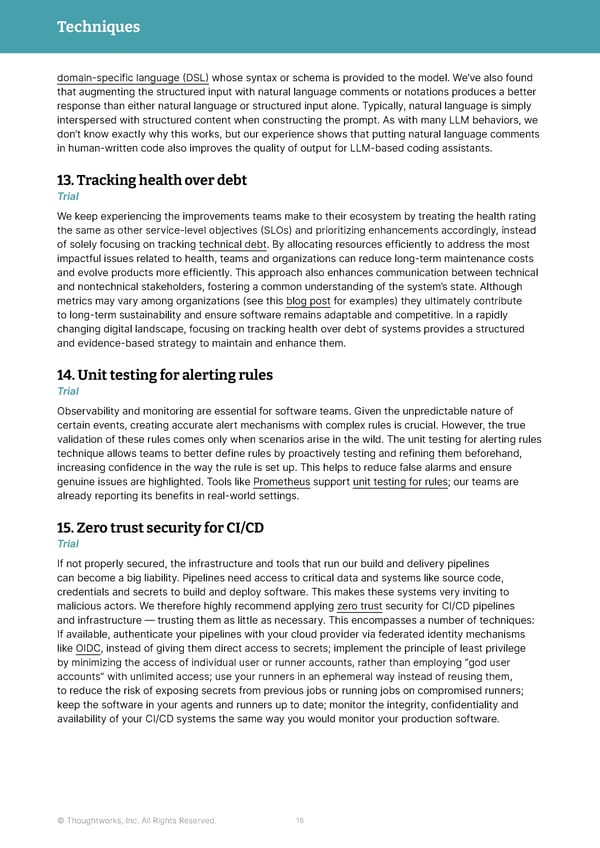Techniques domain-specific language (DSL) whose syntax or schema is provided to the model. We’ve also found that augmenting the structured input with natural language comments or notations produces a better response than either natural language or structured input alone. Typically, natural language is simply interspersed with structured content when constructing the prompt. As with many LLM behaviors, we don’t know exactly why this works, but our experience shows that putting natural language comments in human-written code also improves the quality of output for LLM-based coding assistants. 13. Tracking health over debt Trial We keep experiencing the improvements teams make to their ecosystem by treating the health rating the same as other service-level objectives (SLOs) and prioritizing enhancements accordingly, instead of solely focusing on tracking technical debt. By allocating resources efficiently to address the most impactful issues related to health, teams and organizations can reduce long-term maintenance costs and evolve products more efficiently. This approach also enhances communication between technical and nontechnical stakeholders, fostering a common understanding of the system’s state. Although metrics may vary among organizations (see this blog post for examples) they ultimately contribute to long-term sustainability and ensure software remains adaptable and competitive. In a rapidly changing digital landscape, focusing on tracking health over debt of systems provides a structured and evidence-based strategy to maintain and enhance them. 14. Unit testing for alerting rules Trial Observability and monitoring are essential for software teams. Given the unpredictable nature of certain events, creating accurate alert mechanisms with complex rules is crucial. However, the true validation of these rules comes only when scenarios arise in the wild. The unit testing for alerting rules technique allows teams to better define rules by proactively testing and refining them beforehand, increasing confidence in the way the rule is set up. This helps to reduce false alarms and ensure genuine issues are highlighted. Tools like Prometheus support unit testing for rules; our teams are already reporting its benefits in real-world settings. 15. Zero trust security for CI/CD Trial If not properly secured, the infrastructure and tools that run our build and delivery pipelines can become a big liability. Pipelines need access to critical data and systems like source code, credentials and secrets to build and deploy software. This makes these systems very inviting to malicious actors. We therefore highly recommend applying zero trust security for CI/CD pipelines and infrastructure — trusting them as little as necessary. This encompasses a number of techniques: If available, authenticate your pipelines with your cloud provider via federated identity mechanisms like OIDC, instead of giving them direct access to secrets; implement the principle of least privilege by minimizing the access of individual user or runner accounts, rather than employing “god user accounts” with unlimited access; use your runners in an ephemeral way instead of reusing them, to reduce the risk of exposing secrets from previous jobs or running jobs on compromised runners; keep the software in your agents and runners up to date; monitor the integrity, confidentiality and availability of your CI/CD systems the same way you would monitor your production software. © Thoughtworks, Inc. All Rights Reserved. 16
 Thoughtworks Technology Radar Page 15 Page 17
Thoughtworks Technology Radar Page 15 Page 17